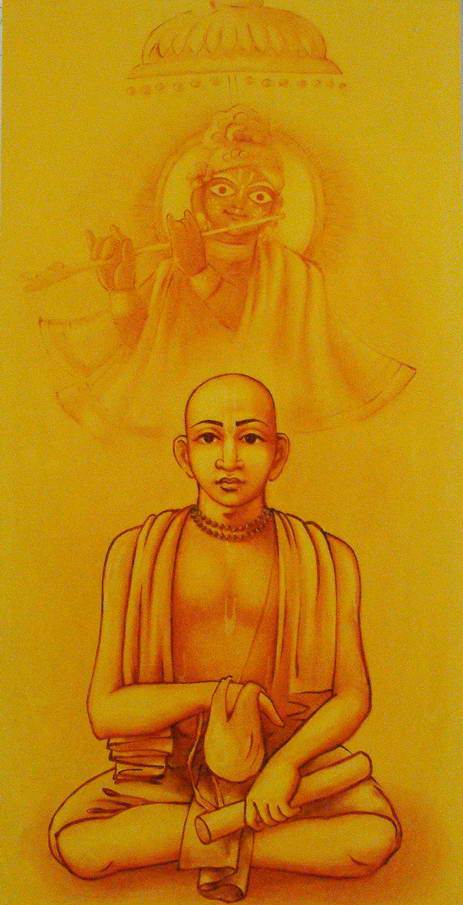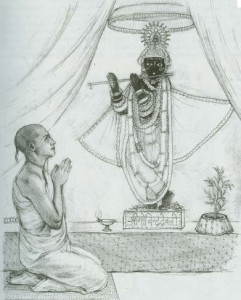
Baladeva Vidyabhusana.
We know that Baladeva studied in one of the villages of the Chilka Lake area in southern Orissa. There he learned grammar, poetics and logic, achieving expertise in all these subjects. He began his studies of Vedanta there, but in order to study the commentaries in greater depth, he went to Mysore. He was there particularly impressed by the logical consistency of the Madhva shuddha-dvaita commentary on the Vedanta sutras and became a disciple of that school and began living in a Tattvavadi monastery. After taking sannyas, he moved to Purushottam Kshetra where he engaged many of the local scholars in debate, demonstrating the depth of his scholarship. His fame soon spread throughout the area.
Later, however, he met Radha Damodar Goswami, a scholar from Kanyakubja, under whose direction he studied Jiva Goswami’s Nat-sandarbha in great detail. When he was convinced of the supremacy of the Gaudiya Vaishnava philosophy, he took initiation from Radha Damodar Goswami. He was thus initiated in Nityananda Prabhu’s line. The following is his disciplic succession: (1) Gauri Das Pandit, (2) Hriday Chaitanya Prabhu, (3) Shyamananda Prabhu, (4) Rasikananda Deva Goswami, (5) Nayanananda Goswami, (6) Radha Damodar Goswami, (7) Baladeva Vidyabhushana.
Baladeva then continued his studies of the Gaudiya literature under Pitambara Das and later studied the Bhagavata Purana under Vishvanath Chakravarti. He also took the Vaishnava vairagi’s dress, at which time he was given the name Ekanti Govinda Das.
He was ordered by Vishvanath Chakravarti Thakur to go to Jaipur where he prayed to Rupa Goswami’s Govindaji murti for the authorization to write a commentary on the Vedanta-sutra. He then composed the Govinda-bhashya and took it to Galta where he defeated the other sampradayas in debate, preserving the reputation of the Gaudiya school. After this episode, he was given the title Vidyabhushana. This story has been told in greater detail in this volume in the chapter on Vishvanath Chakravarti Thakur.

Baladeva Vidyabhusana was ordered by Vishvanath Chakravarti Thakur to go to Jaipur where he prayed to Rupa Goswami’s Govindaji murti for the authorization to write a commentary on the Vedanta-sutra.
The following is a list of Baladeva Vidyabhushana’s written works:
(1) A commentary on the Brahma Sutras, Govinda-bhashya;
(2) Siddhanta-ratnam,
(3) Vedanta-syamantaka,
(4) Prameya-ratnavali,
(5) Siddhanta-darpana,
(6) Sahitya-kaumudi,
(7) Kavya-kaustubha,
(8) Vyakarana-kaumudi (which appears to have been lost);
(9) Pada-kaustubha,
(10) Vaishnava-nandini, a commentary on the Tenth Canto,
(11) A commentary on Gopal-tapani Upanishad;
(12) Commentaries on the Isha and nine other upanishads;
(13) Gitabhushana-bhashya, a commentary on Bhagavad-gita;
(14) Namarthasudha, a commentary on the Vishnusahasranama;
(15) Saranga-rangada, a commentary on the Laghubhagavatamrita;
(16) Stavamala-vibhushana, a commentary on Stavamala;
(17) a commentary on Rupa Goswami’s Natika-candrika;
(18) Chandah-kaustubha-bhashya;
(20) A commentary on Rasikananda’s Shyamananda-shataka;
(21) A commentary on Candraloka (which appears to have been lost);
(22) Krishnanandini, a commentary on Sahitya-kaumudi;
(23) Govindabhashya-tika, a commentary on his own Govinda-bhashya;
(24) Sukshma, a further clarification of his own Siddhanta-ratnam;
Other than these, it is claimed that Baladeva also wrote an Aishvarya-kadambini which is different from that written by Vishvanath Chakravarti Thakur. In the Aishvarya-kadambini by Vishvanath, there is a discussion of the dvaita and advaita doctrines, which is missing from Baladeva’s work of that name.
It is said that Baladeva established the worship of the Vijaya Gopal Deity in Galta. His two most prominent disciples were Uddhava Das and Sri Nanda Mishra.
In the succession of bona-fide gurus which make up the Madhva-Gaudiya-Sarasvata-Vaishnava sampradaya, Baladeva Vidyabhushana is to be remembered regularly. Simply demonstrating a connection through initiation to a family succession of initiating spiritual masters does not make one a bona-fide guru. One must demonstrate complete dedication to the supreme truth, brahma-nishtha. Only a pure Devotee can be called a bona-fide guru.
[Excerpted from “Sri Chaitanya: His Life & Associates” by Srila Bhakti Ballabh Tirtha Maharaj]